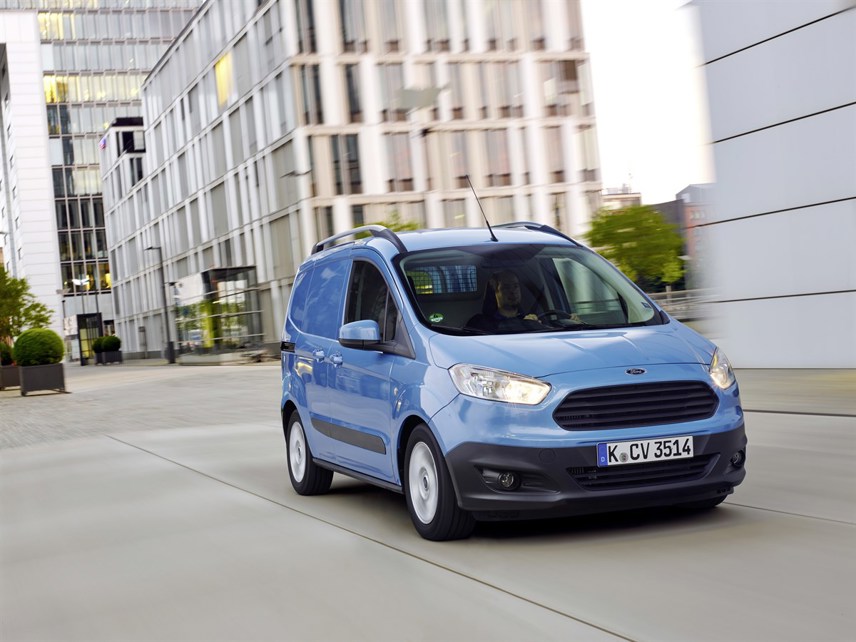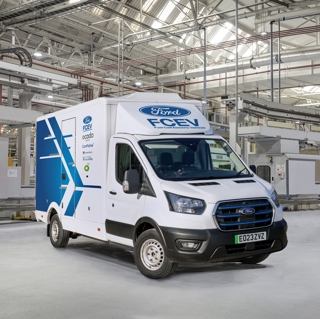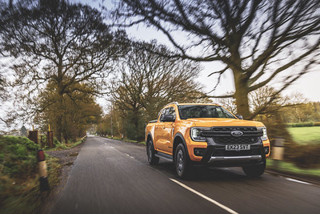Review
Ford has launched the new Transit Courier at a perfect time. Fleets across all industry segments are undertaking utilisation and efficiency work to determine the right size and number of vehicles they need to operate to fulfil their business requirements.
In many cases, this is resulting in downsizing: from large panel vans to medium; from medium to small; and from small to compact vans. Ford hopes to capitalise on this trend with its first vehicle in the compact van segment.
The Transit Courier is compact on the outside but surprisingly roomy inside with a 660kg payload capacity.
Ford says the 1.9cu.m (VDA) cargo space - 10% larger than its rivals and at least 10cm longer at 1.6 metres - is almost as big as vans in the class above, while the passenger seat folds flat to accommodate items up to 2.59 metres in length.
Easy access highlights include a standard single side-load door on the Trend derivative (claimed to be 60mm wider than competitors) and optional dual side-load door on both Trend and Base. Fleets can also choose from a range of bulkhead designs.
Ford LCV product marketing manager Mark Easton believes many vans in the compact segment have under-performed in terms of useable space. The Courier’s increased capacity should encourage more fleets to consider downsizing.
“We will grow the segment – it has some way to go before it reaches maturity – and we will also take conquests from rival models,” said Easton.
He pointed towards Fiat Fiorino, Peugeot Bipper, Citroen Nemo and Mercedes-Benz Citan compact as the prime targets, adding that Ford expected to sell between 5,000 and 8,000 in a full year.
Ford is claiming a number of industry firsts for the Courier, including a device dock to hold a mobile phone or portable sat-nav and its EasyFuel system, which prevent misfuelling. Segment firsts include central remote locking, an under-seat storage drawer, deep centre console and overhead storage shelf (although this felt a little flimsy).
Optional additions include Ford’s in-car connectivity system Sync with emergency assist and Applink on the Trend trim, sat-nav, cruise control and reversing camera.
The 1.5-litre 75hp diesel on test here is one of two diesel options (the larger 1/6-litre 95hp will be the unit of choice for user-choosers and sole traders). Fleets also have the option of a 1.0-litre 100hp Ecoboost petrol, a willing and efficient performer (54.3mpg with stop-start) that would be perfectly suited to urban delivery and lower mileage operators.
The 1.5-litre 75hp in Base trim will be the mainstay of fleets (power/utilities, security companies, motor factors and local authorities are key targets), accounting for 70% of sales.
The engine achieves a 72.4mpg paper figure with stop-start (68.9mpg without) and pulls well at low revs in a high gear, reducing the need for multiple gear changes. Although tested unloaded, it didn’t struggle for power and provided a refined driving experience.
The ride is class-leading, although occasionally bouncy without a load in the back. Handling is excellent.
With strong residual values (Easton: “as good as or better than we’d hoped”) and low maintenance costs (including 20,000-mile servicing schedules), Ford claims total cost of ownership of this model is £1,600-2,500 lower than comparable rivals. It expects segment leadership within 18 months of launch.
Specs
| Manufacturer | Ford |
| Model | Transit Courier Light Commercial |
| Specification | Ford Transit Courier Diesel 1.5 EcoBlue Trend Van |
| Model Year | 2026.00 |
| Annual VED (Road tax) | £1035 |
| BIK List Price | £22,417 |
| CO2 | 145g/km |
| Insurance Group | N/A |
| CC | 1,499 |
| Fuel Type | |
| Vehicle Type | Small van |
| Luggage capacity (Seats up) | N/A |
Running Costs
| P11D | £22,417 |
| Cost per mile | 39.00ppm |
| Residual value | £8,150 |
| Insurance group | N/A |
| Fuel Type | |
| Cost per mile | 39.00ppm |
| Fuel | 10.82ppm |
| Depreciation | 23.87ppm |
| Service maintenance and repair | 4.30ppm |
Info at a glance
-
P11D Price
£22,417
-
MPG
50.4 -
CO2 Emissions
145g/km -
Payload
N/A -
Load Volume
N/A -
Load Width
N/A -
Load Length
4,337mm

























Jeff - 04/07/2015 06:51
I have the Trend 1.5 diesel. Since new I get the odd misfire, this is on distance driving and happens everyday and lasts for anything between a few seconds, up to a couple of minutes. I have taken it to the Ford dealership but they cant see the fault on their computer and told me to live with it. In time they MAY be able to help if others have the same problem. Not very comforting